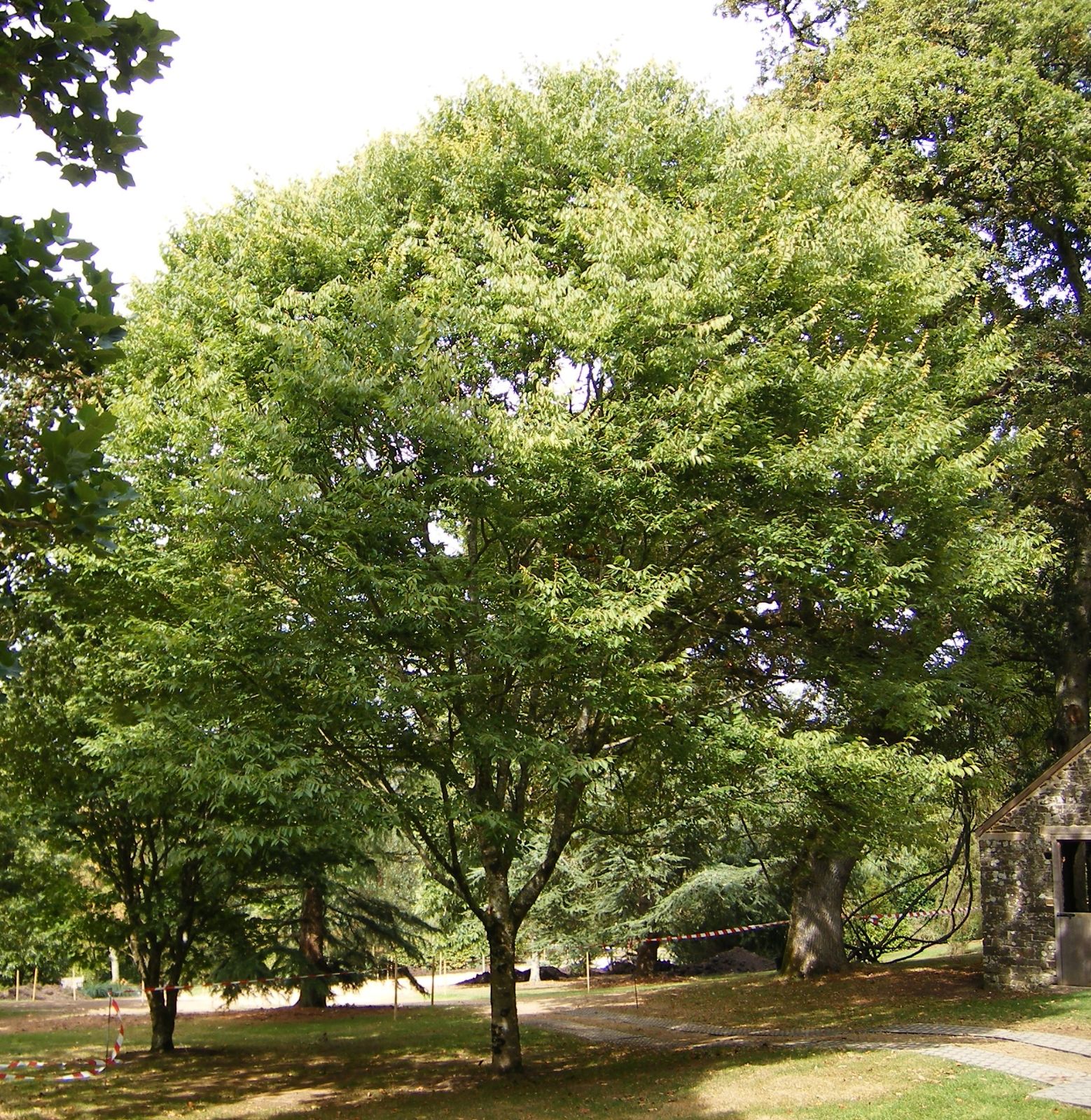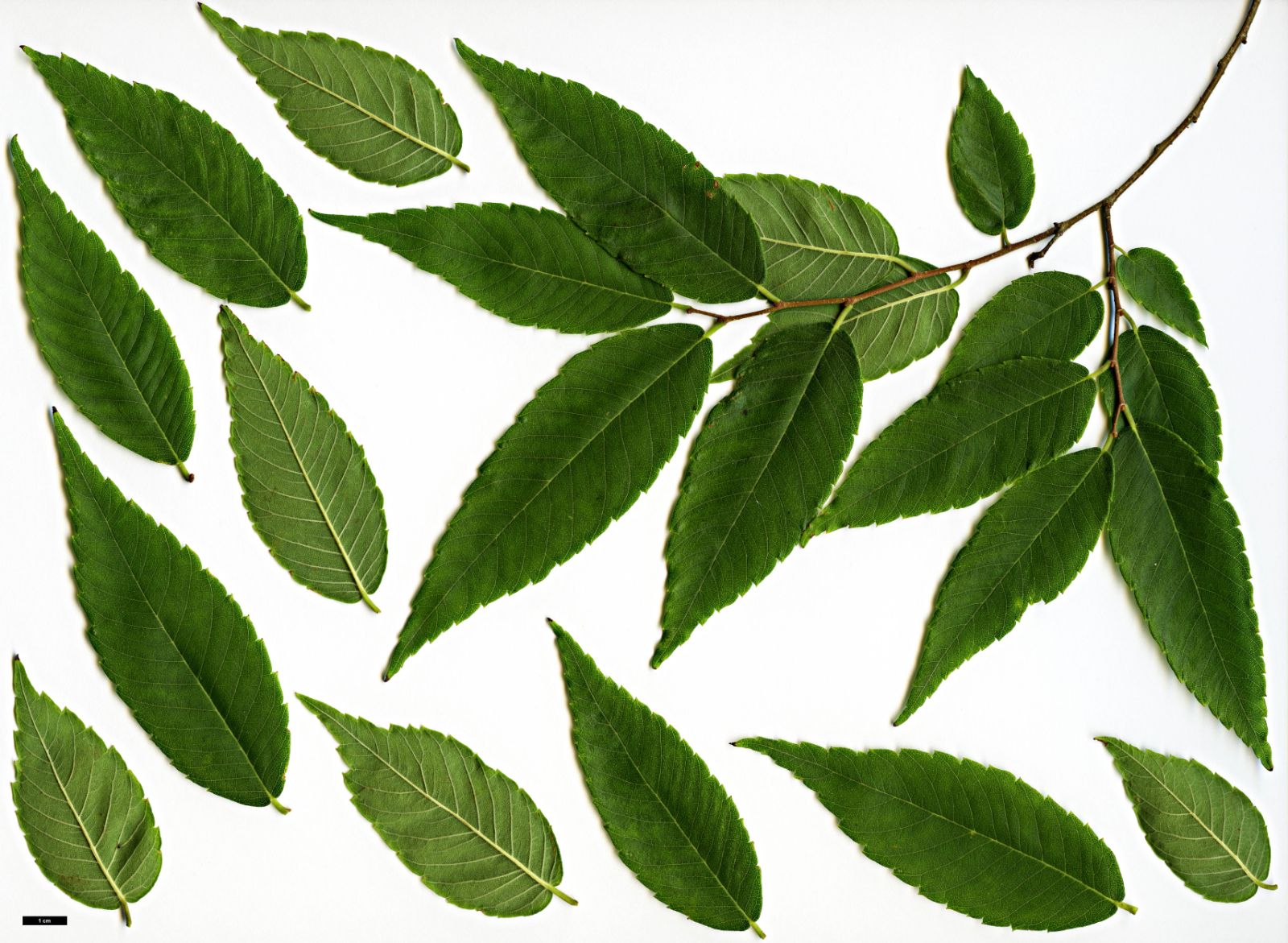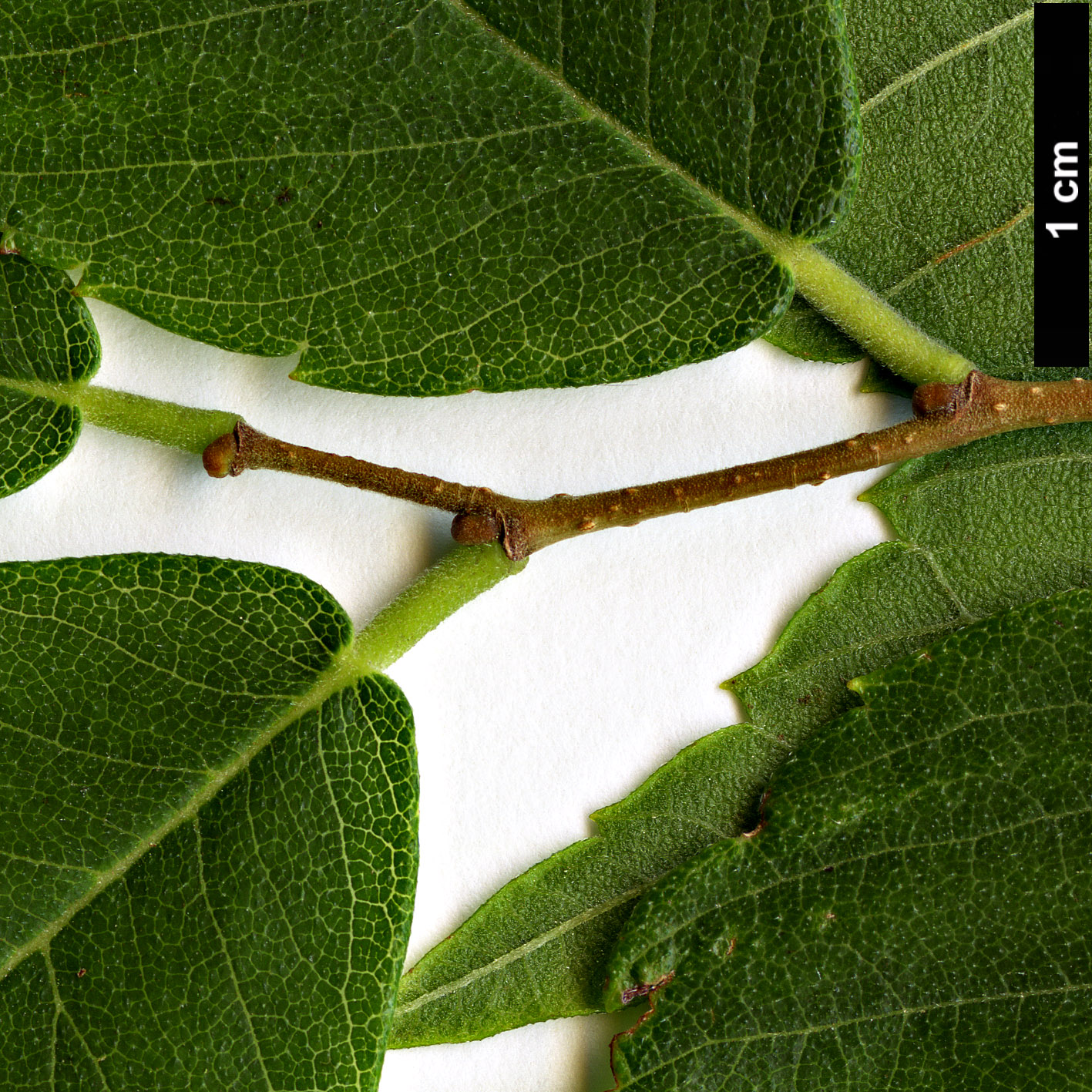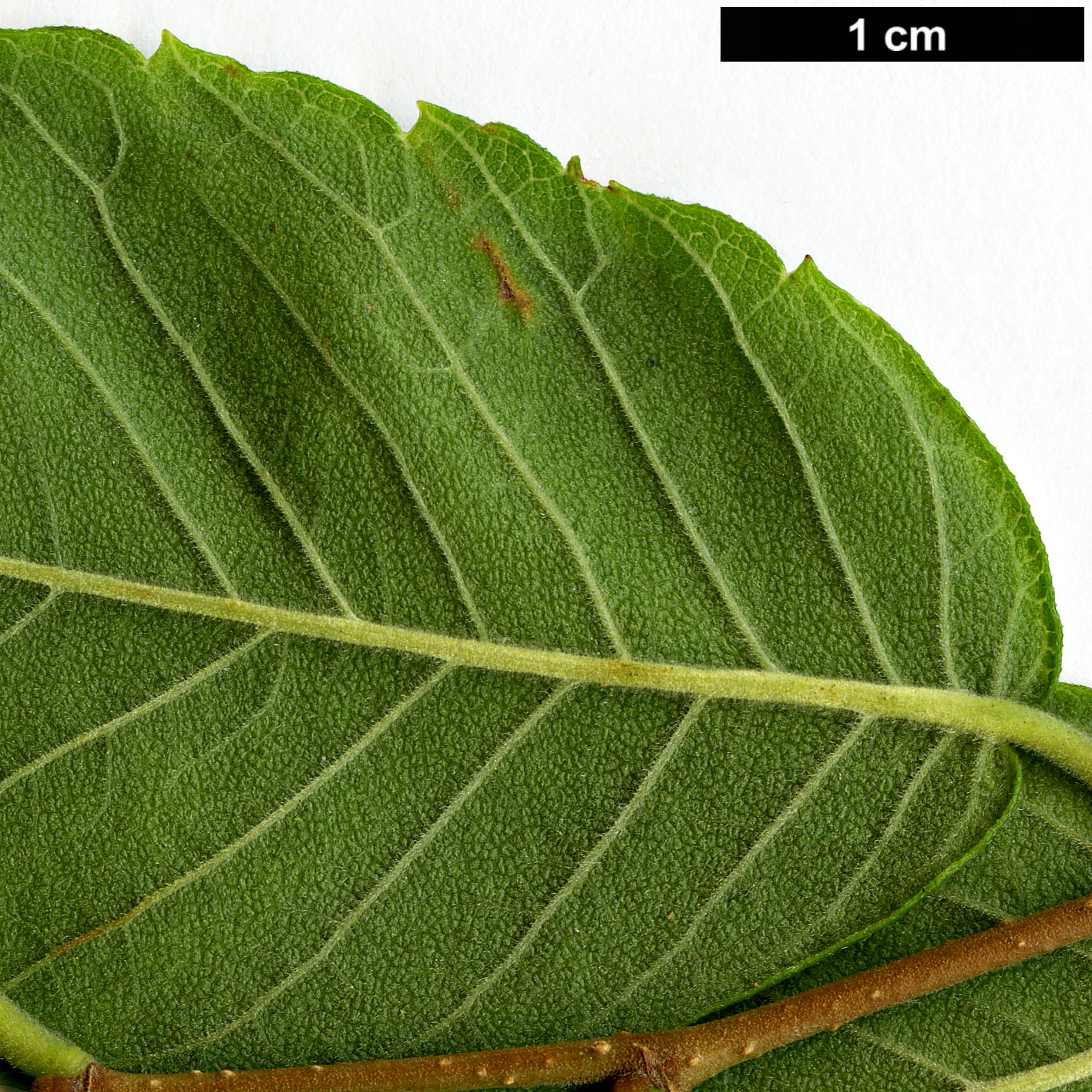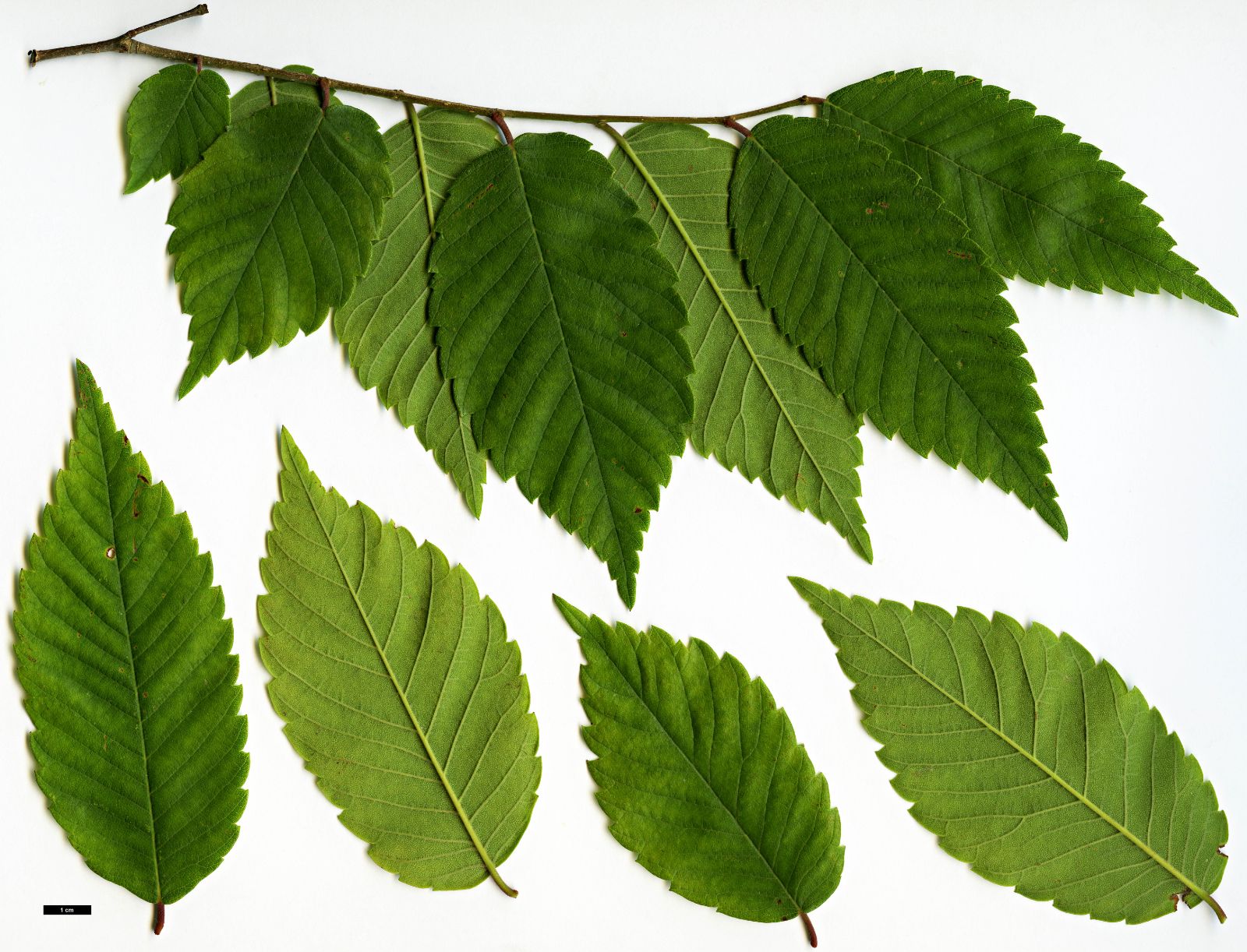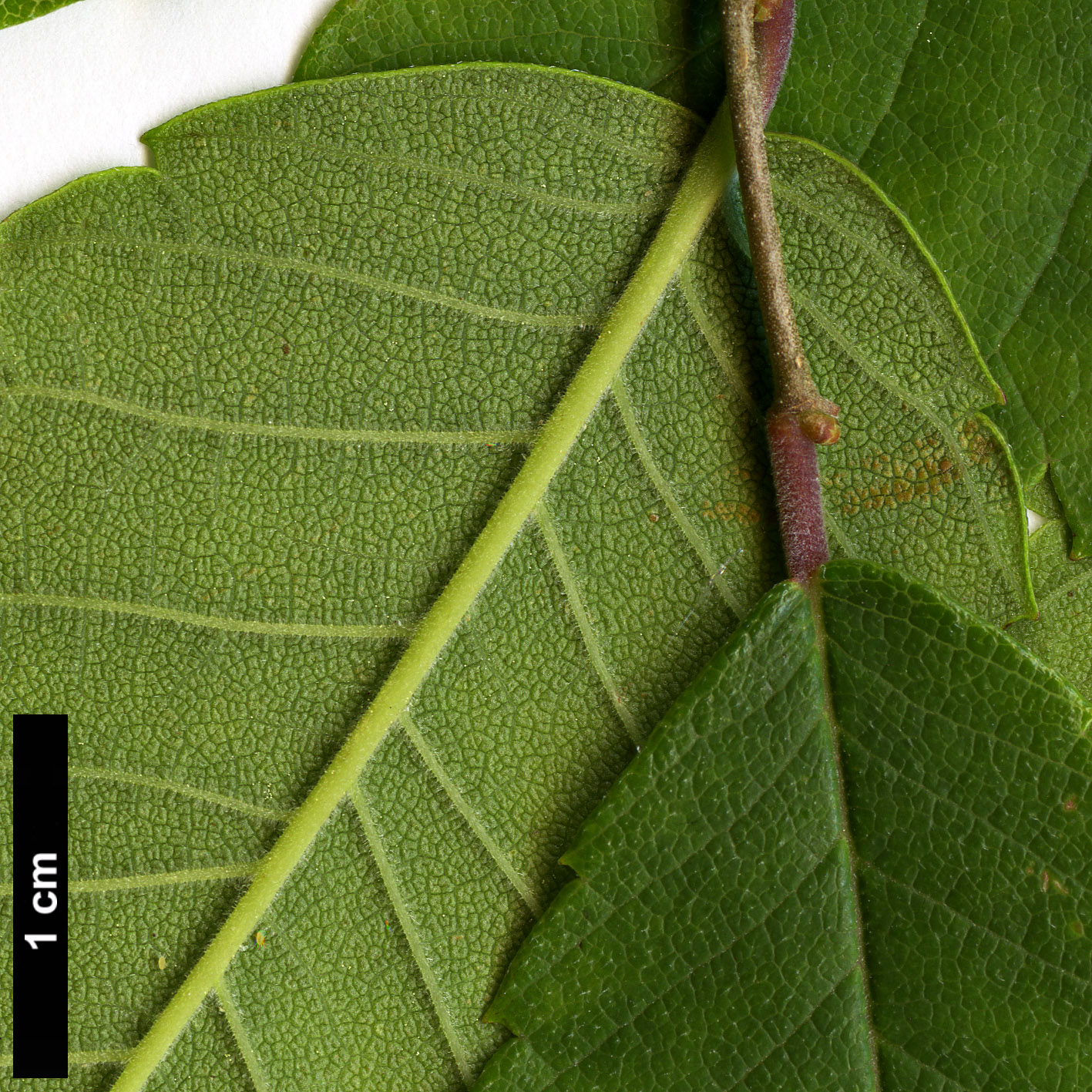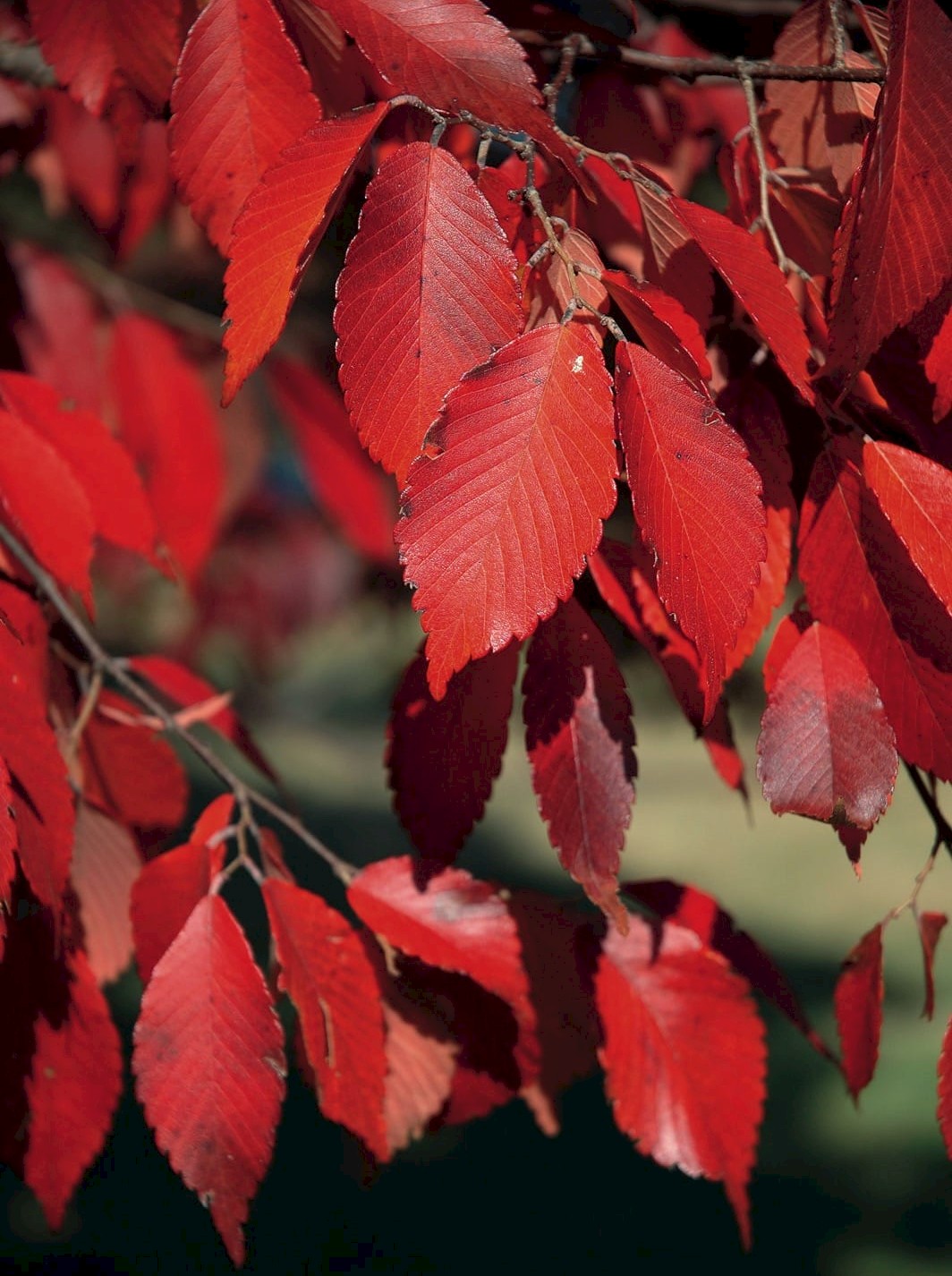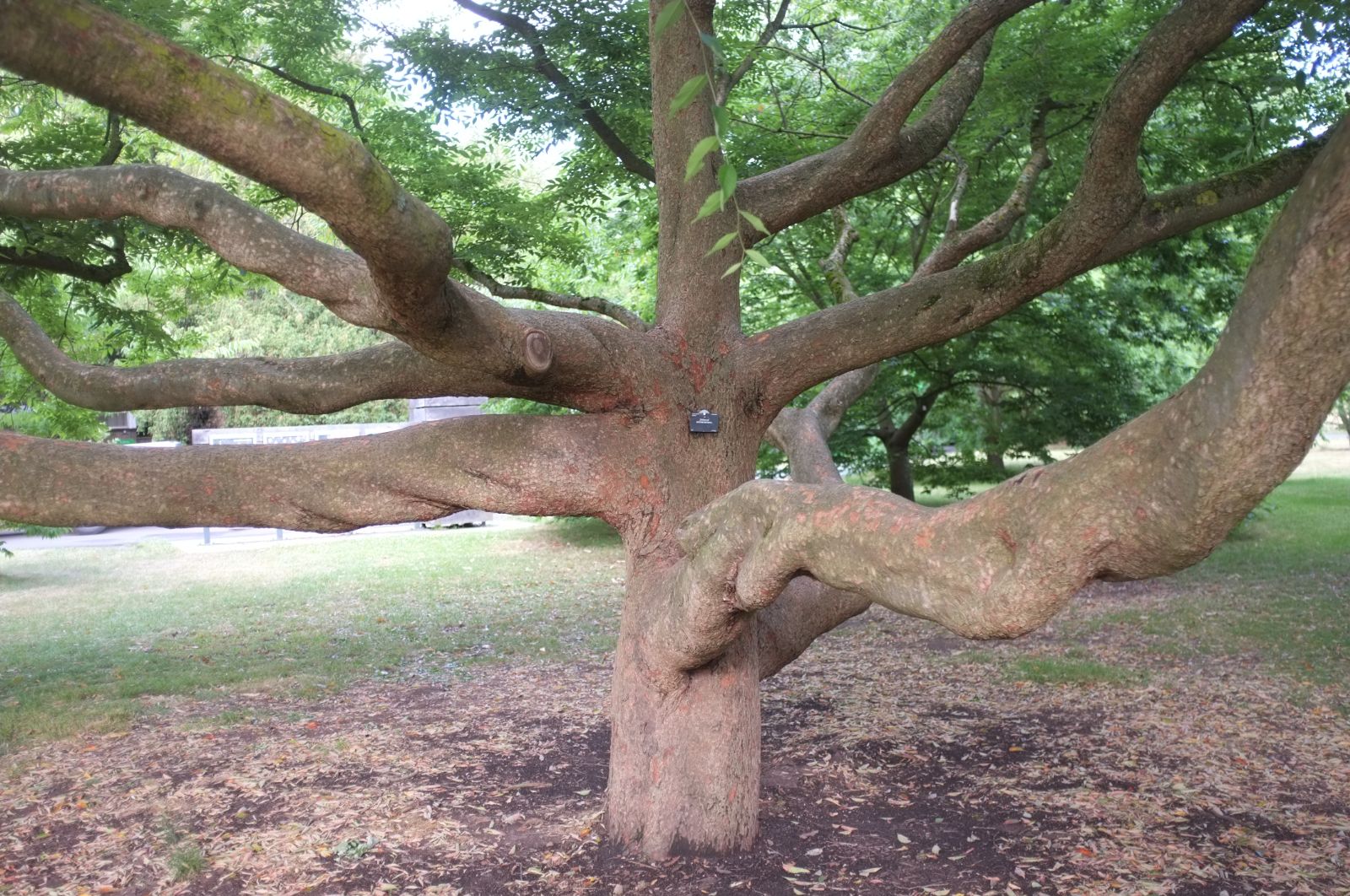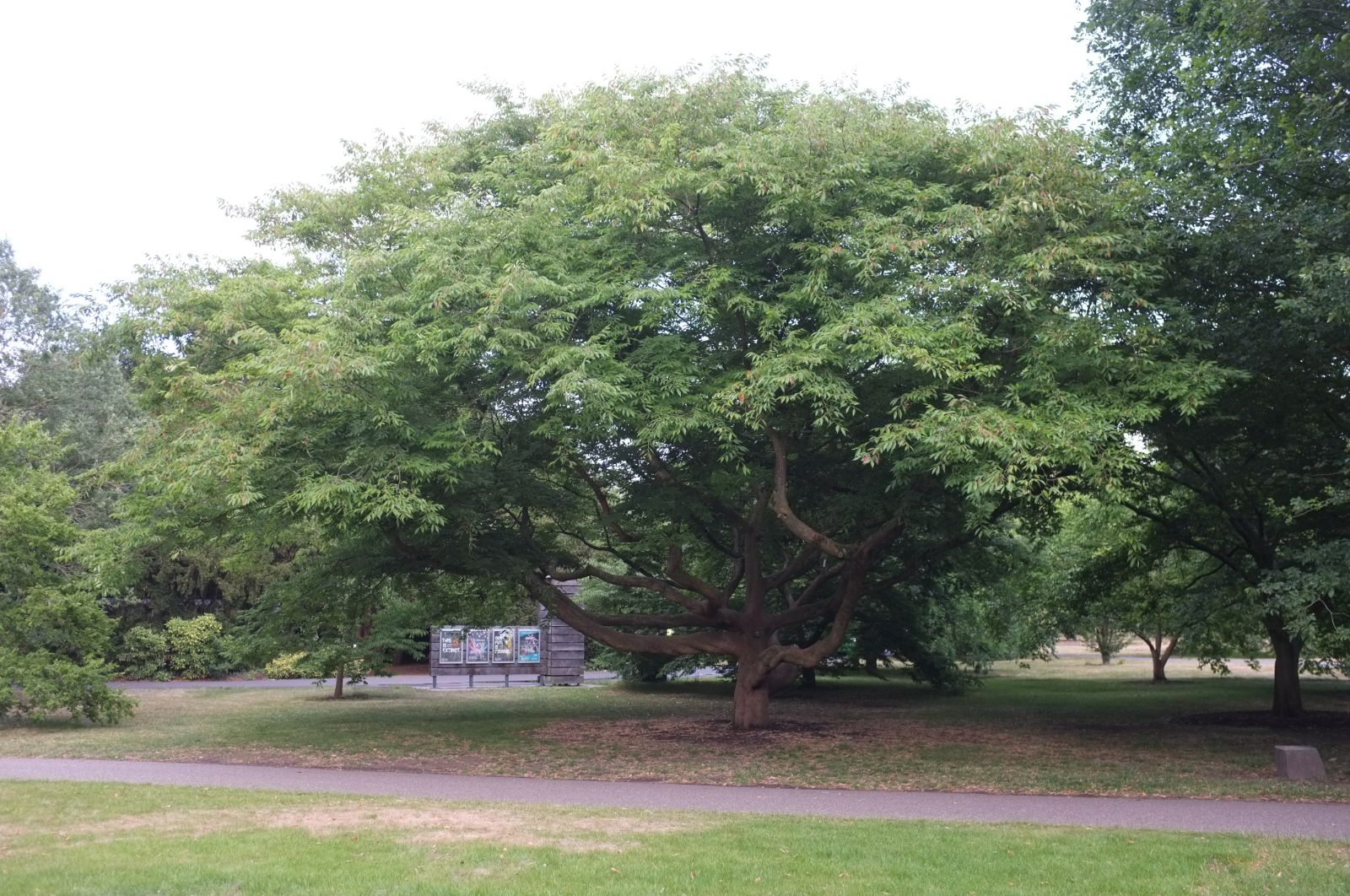Zelkova schneideriana
Sponsor
Kindly sponsored by
Francine: 'after many informative Tours and Study Days with the IDS I feel it only fitting to help and promote such a wonderful organisation'
Credits
Owen Johnson (2023)
Recommended citation
Johnson, O. (2023), 'Zelkova schneideriana' from the website Trees and Shrubs Online (treesandshrubsonline.
Genus
Common Names
- Chinese Elm
Synonyms
- Zelkova tarokoensis Hayata
- Zelkova serrata var. tarokoensis (Hayata) H. L. Li
- Zelkova formosana Hayata
Infraspecifics
Large, tree to 35 m tall. Bark grey, sometimes scaling in fine flakes to show the amber under-bark, or remaining smooth, or developing rougher plates. Young twigs densely covered with whitish hairs; buds conic to ovoid. Leaves ovate to elliptic-lanceolate, 3–10 × 2–4 cm, slightly oblique at the base, the tip acute to acuminate; major side veins in 8–15 pairs, each leading to a large, sharp but round-shouldered tooth which is often apiculate; texture thickly papary, upper surface dark and very rough (strigose), lower surface densely pubescent; flushing reddish; petiole short (3–7 mm), very hairy. Drupe small (2.5–3.5 mm wide), networked with irregular ridges. (Fu, Xin & Whittemore 2003; Bean 1981).
Distribution China Anhui, Fujian, S Gansu, Guangdong, Guangxi, Guizhou, S Henan, Hubei, Hunan, Jiangsu, Jiangxi, S Shaanxi, SE Sichuan, SE Xizang, Yunnan, Zhejiang Taiwan
Habitat Mountain forests, often near streams, to 2800 m in Xizang and Yunnan.
USDA Hardiness Zone 6
RHS Hardiness Rating H6
Conservation status Vulnerable (VU)
Zelkova schneideriana is quite closely related to Z. serrata, which enjoys a slightly more northerly distribution across east Asia and which is much the more familiar tree in cultivation in the west; the former is distinguishable by its general hairiness, while many short stiff hairs give a sandpapery texture to the upper leaf surface which suggests a species of elm. These rough and hairy leaves are a particularly matt, dark green in summer, but the autumn display of red and yellow can be the brightest in the genus (though it can also be distinctly lacklustre, barely changing from green), and, like many trees from southern China, the spring flush can also be colourful red or pink. As with other zelkovas, the bark can flake prettily to reveal patches of the amber or cinnamon underbark, but the outer layer tends to be a darker and duller grey and in some specimens this colour remains uniform.
The features differentiating Z. schneideriana from Z. serrata are far from clear-cut: a 1934 introduction from Nanjing, Jiangsu, to the United States was identified by American botanists as Z. schneideriana but had been sent by their Chinese counterparts as Z. serrata (Grimshaw & Bayton 2009). Some Japanese populations which are conventionally considered to be Z. serrata – and are occasionally differentiated as var. stipulacea Makino – show leaves which, rather like those of Z. schneideriana, are hairy across both sides (Grimshaw & Bayton 2009). An isolated Zelkova population in the Taroko Gorge in Taiwan was originally described by Bunzō Hayata as a new species (Z. formosana or Z. tarokoensis) and was then universally treated as a local form of Z. serrata; a 2019 phylogenetic study showed these trees to lie comfortably within Z. schneideriana (Naciri et al. 2019).
In common with the other zelkovas Z. schneideriana is a relict tree, seldom reproducing abundantly and enjoying a range which, although still geographically wide, is now much fragmented (Kozlowski & Gratzfeld 2013; Kozlowski et al. 2018); it is threatened by logging, urbanisation and forest-clearance for farming. An estimated 3000–5000 mature trees survive, in about a hundred subpopulations (Kozlowski et al. 2018). The timber is strong and durable, and fibre from the bark is traditionally used for making ropes and paper (Fu, Xin & Whittemore 2003). Z. schneideriana is now extensively planted for forestry in southern China (Zhang et al. 2022), but such plantations tend to contain low genetic diversity.
In cultivation in the west this remains perhaps the least familiar member of its genus. (Zelkova sicula is still less often seen, but its recent discovery and extreme rarity in the wild have given this species a degree of horticultural celebrity.) The vernacular name ‘Chinese Zelkova’ promoted in the United States for Z. schneideriana is perhaps unhelpful, as this name has been used in the UK and Ireland for Z. sinica, a Chinese endemic.
Z. schneideriana was first described in 1929 by the Austrian botanist Heinrich Handel-Mazzetti, who named it after Camillo Schneider, his colleague in China in 1913–1915 (Grimshaw & Bayton 2009). The first introduction to North America came by accident: in 1934 the director of the Sun Yat-Sen Tomb and Memorial Park Commission, Nanjing, China presented seed of what he believed to be Z. serrata to the United States Department of Agriculture (Pl 105331). A single seedling was established at the Glenn Dale Plant Introduction Station in Maryland, where it was identified as Z. schneideriana by Frederick Meyer, Frank Santamour and also Stephen Spongberg (Grimshaw & Bayton 2009). This grew into a beautiful round-headed tree which, in the continental climate of the East Coast, was celebrated for its magnificent red fall colours, but had apparently gone by 2019 (Maryland-National Capital Park and Planning Commission 2019). Another specimen in the eastern United States grew at the J.C. Raulston Arboretum in North Carolina and was about 12 m × 53 cm dbh in 2007 (Grimshaw & Bayton 2009); it died in that same year, and its attractive timber was turned into a set of memorial bowls (Lloyd & Peterson 2012). It had been obtained from the United States National Arboretum, but was believed to have derived from a second introduction from China made soon after the Second World War (Lloyd & Peterson 2012).
The premature demise of these two specimens might suggest that Z. schneideriana is imperfectly adapted to the climate of the eastern United States. There have been a few urban plantings in streets and carparks in North Carolina, but these often show stress, including die-back in the crown centre and bark cracks (North Carolina Co-operative Extension 2023). In Fayetteville, Arkansas, however, a tree of unknown provenance planted in 1993 shows good drought tolerance (University of Alabama Division of Agriculture 2023). The Arnold Arboretum in Massachusetts holds several specimens, accessioned in 1979 and 1980 (Arnold Arboretum 2023). The United States National Arboretum (Washington DC) obtained further seed from the Chinese Academy of Forestry in 1981, and a NACPEC expedition introduced seed from Hubei in 1994 (Grimshaw & Bayton 2009); a seedling from this introduction has done particularly well at the Morris Arboretum of the University of Pennsylvania, where it turns wine-red in the fall (Dirr 2009) but lacks the flaking, patchwork bark which is such an attractive feature of most zelkovas (Hatch 2021–2022).
Zelkova schneideriana was at the Arboretum National des Barres in France by the mid 1960s (Andrews 1994), while another mature French example grows at Arboretum Adeline (Adeline & Adeline 2023). The species first reached Britain in 1977 in the form of seed from Nanjing in China (Grimshaw & Bayton 2009); at Kew, the survivor of a pair of seedlings has grown into a beautiful tree with remarkably sturdy and numerous spreading limbs which show off its brightly flaking bark to maximum advantage (Tree Register 2023), but seedlings raised by the late Harry Hay in his arboretum next to Junction 8 of the M25 on top of the North Downs in Surrey all died back to the base and most were subsequently killed by winter waterlogging (Grimshaw & Bayton 2009). Elsewhere in the UK the species has generally thrived; the champions are trees of 11 m × 58 cm diameter near the base at RHS Garden Wisley (planted in 1982) and a particularly graceful specimen of 13 m × 40 cm dbh at Rosemoor (planted in 1980; Tree Register 2023). At Sheffield Park in East Sussex, a conspicuous example by the cascade from the third lake earns its place among the many trees planted here for their colourful autumn displays. Z. schneideriana has also done well in the hot dry summers of the Cambridge University Botanic Garden (another 1980 planting) and in the cooler conditions of the Yorkshire Arboretum (1982 plantings; Tree Register 2023). It should however be observed that none of these cultivated trees seem set to rival the giant stature of species may attain in the wetter forests of subtropical southern China.
'Gold Goblin'
Synonyms / alternative names
Zelkova schneideriana 'Hen Tian Gao'
Zelkova schneideriana 'Jin1301'
Among millions of seedlings raised for forestry use at Longyan, Fujian Province, China, a slow-growing and compact plant with yellow rather than red autumn colour was selected in 2010. From 2013, grafts of ‘Gold Goblin’ were trialled at the South Central University of Forestry and Technology in Changsha, Hunan, China, and at the University of Georgia, USA. In China, the yellow leaves hang on until January. ‘Gold Goblin’ was released in 2022 (Zhang et al. 2022; Hatch 2021–2022).

